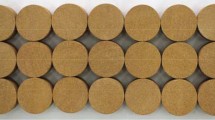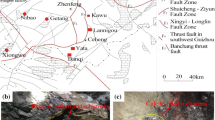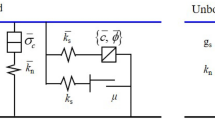Abstract
Rocks are a typical kind of heterogeneous material composed of differences in size, shape, type, and mineral particle distribution. The strength and deformation characteristics of rocks are controlled by their internal heterogeneous structures. A numerical model was built to analyse the strength and failure characteristics of sandstone samples with randomly distributed heterogeneous. The results revealed that heterogeneous structures induce local stress concentrations and accelerate sample failure. At a loading rate of 0.01 mm/s, the mechanical properties of sandstone samples with soft heterogeneous particles are uniformly smaller than those of standard sandstone samples, while those of sandstone samples with hard heterogeneous particles follow different variation rules, depending on the specific heterogeneous particle content. With the differences between heterogeneous particles and sandstone particles in properties, an increase is observed in the mechanical properties of samples with different heterogeneous particle contents. Soft heterogeneous structures determine the crack initiation position of the main crack and the development and propagation space of cracks through their distribution pattern, while hard heterogeneous structures are load-bearing and change crack propagation paths. When there are multiple structures with different properties in rocks, micro-cracks occur first between soft heterogeneous particles, and the distribution pattern of soft heterogeneous particles determines the ultimate failure mode of samples as well as the propagation paths and development space of cracks.














Similar content being viewed by others

Data availability
The data are available and explained in this article, further inquiries can be directed to the corresponding author.
References
Bewick RP, Kaiser PK, Amann F (2018) Strength of massive to moderately jointed hard rock masses. J Rock Mech Geotech Eng 11(3):562–575
Blair SC, Cook NGW (1998) Analysis of compressive fracture in rock using statistical techniques: part II. Effect of microscale heterogeneity on macroscopic deformation. Int J Rock Mech Min Sci 35(7):849–861
Chen M, Zang CW, Ding ZW, Zhou GL, Jiang BY, Zhang GC, Zhang PC (2022) Effects of confining pressure on deformation failure behavior of jointed rock. J Cent South Univ 29(4):1305–1319
Chen Y, Zuo JP, Guo BH, Guo WB (2020b) Effect of cyclic loading on mechanical and ultrasonic properties of granite from Maluanshan Tunnel. B Eng Geol Environ 79:299–311
Chen SJ, Xia ZG, Feng F, Yin DW (2021) Numerical study on strength and failure characteristics of rock samples with different hole defects. B Eng Geol Environ 80:1523–1540
Chen YL, Zuo JP, Liu DJ, Wang ZB (2019a) Deformation failure characteristics of coal–rock combined body under uniaxial compression: experimental and numerical investigations. B Eng Geol Environ 78:3449–3464
Chen SJ, Yin DW, Jiang N, Wang F, Zhan ZH (2019b) Mechanical properties of oil shale-coal composite samples. Int J Rock Mech Min Sci 123:104–120
Chen SJ, Ren MZ, Wang F, Yin DW, Chen DH (2020a) Mechanical properties and failure mechanisms of sandstone with pyrite concretions under uniaxial compression. Geomech Eng 22(5):385–396
Gao FQ, Kang HP, Wu YZ (2016) Experimental and numerical study on the effect of calcite on the mechanical behaviour of coal. Int J Coal Geol 158(15):119–128
Ghasemi S, Khamehchiyan M, Taheri A, Nikudel MR, Zalooli A (2020) Crack evolution in damage stress thresholds in different minerals of granite rock. Rock Mech Rock Eng 53:1163–1178
Greno GL, Otegui JL, Boeri RE (1999) Mechanisms of fatigue crack growth in austempered ductile iron. Int J Fatigue 21(1):35–43
Huang LK, Liu JJ, Zhang FS, Dontsov E, Damjanac B (2019) Exploring the influence of rock inherent heterogeneity and grain size on hydraulic fracturing using discrete element modeling. Int J Solids Struct 176–177:207–220
Itasca Consulting Group (2008) PFC2D (particle flow code in 2 dimensions) fish in PFC2D, Itasca Consulting Group, Minneapolis, U.S.A
Janeiro RP, Einstein HH (2010) Experimental study of the cracking behavior of specimens containing inclusions under uniaxial compression. Int J Fracture 164:83–102
Jiang S, Huang M, Wu XZ, Chen ZF, Zhang KS (2021) Deterioration behavior of gypsum breccia in surrounding rock under the combined action of cyclic wetting-drying and flow rates. B Eng Geol Environ 80:4985–5001
Lee HP, Olson JE, Schultz RA (2018) Interaction analysis of propagating opening mode fractures with veins using the discrete element method. Int J Rock Mech Min Sci 103:275–288
Leite MH, Boivin V, Corthesy R (2019) Stress calculation methods for overcoring techniques in heterogeneous rocks. Int J Rock Mech Min Sci 47(7):1180–1192
Liu G, Cai M, Huang M (2018) Mechanical properties of brittle rock governed by micro-geometric heterogeneity. Comput Geotech 104(12):358–372
Lv HY, Tang YS, Zhang LF, Cheng ZB, Zhang YN (2019) Analysis for mechanical characteristics and failure models of coal specimens with non-penetrating single crack. Geomech Eng 17(4):355–365
Ma Q, Tan YL, Liu XS, Gu QH, Li XB (2020) Effect of coal thicknesses on energy evolution characteristics of roof rock-coal-floor rock sandwich composite structure and its damage constitutive model. Compos Part B-Eng 198:108086.1-108086.11
Manouchehrian A, Cai M (2016) Influence of material heterogeneity on failure intensity in unstable rock failure. Comput Geotech 71(1):237–246
Molladavoodi H, Rahimirezaei Y (2018) Heterogeneous rock simulation using DIP-Micromechanics-Statistical methods. Adv Civ Eng 2018:7010817.1-7010817.10
Noori M, Khanlari G, Rafiei B, Sarfarazi V, Zaheri M (2022a) Estimation of brittleness indexes from petrographic characteristics of different sandstone types (cenozoic and mesozoic sandstones), Markazi Province, Iran. Rock Mech Rock Eng 55:1955–1995
Noori M, Khanlari G, Sarfarazi V, Rafiei B, Nejati HR, Schubert W (2022b) Experimental test and numerical simulation of the effect of brittleness on the microfracturing of sandstone. B Eng Geol Environt 81(8):1–27
Ortiz J, Cisilino AP, Otegui JL (2000) Boundary element modelling of fatigue crack propagation in ductile iron. Eng Anal Bound Elem 25(6):467–473
Pardoen B, Bésuelle P, Pont SD, Cosenza P, Desrues J (2020) Accounting for small-scale heterogeneity and variability of clay rock in homogenised numerical micromechanical response and microcracking. Rock Mech Rock Eng 53:2727–2746
Potyondy DO, Cundall PA (2004) A bonded-particle model for rock. Int J Rock Mech Min Sci 41(8):1329–1364
Rastegarnia A, Alizadeh SMS, Esfahani MK, Amini O, Utyuzh AS (2020) The effect of hydrated lime on the petrography and strength characteristics of Illite clay. Geomech Eng 22(2):143–152
Salimidelshad Y, Moradzadeh A, Kazemzadeh E, Pourafshary P, Majdi A (2019) Experimental investigation of changes in petrophysical properties and structural deformation of carbonate reservoirs. Petrol Explor Dev 46(3):565–575
Tian WL, Yang SQ, Huang YH, Yin PF, Zhu ZN, Sun BW (2022) Meso-fracture mechanism of granite specimens under high temperature and confining pressure by numerical simulation. Chin J Rock Mech Eng 41(09):1810–1819
Tian WL, Yang SQ, Huang YH (2017) PFC2D simulation on crack evolution behavior of brittle sandstone containing two coplanar fissures under different confining pressures. J Min Saf Eng 34(06):1207–1215
Wang F, Xu JL, Xie JL (2019a) Effects of arch structure in unconsolidated layers on fracture and failure of overlying strata. Int J Rock Mech Min Sci 114:141–152
Wang F, Konietzky H, Herbst M (2019b) Influence of heterogeneity on thermo-mechanical behaviour of rocks. Comput Geotech 116:103184.1-103184.13
Wu ZJ, Liang X, Liu QS (2015) Numerical investigation of rock heterogeneity effect on rock dynamic strength and failure process using cohesive fracture model. Eng Geol 197(10):198–210
Xia ZG, Chen SJ, Liu XZ, Sun R (2020) Strength characteristics and fracture evolution of rock with different shapes inclusions based on particle flow code. Geomech Eng 22(5):461–473
Xue DJ, Zhou HW, Zhao YW, Zhang L, Deng LS, Wang XY (2018) Real-time SEM observation of mesoscale failures under thermal-mechanical coupling sequences in granite. Int J Rock Mech Min Sci 112:35–46
Yang SQ, Huang YH (2014) Experiment and particle flow simulation on crack coalescence behavior of sandstone specimens containing double holes and a single fissure. J Basic Sci Eng 22(3):584–597
Zhao TB, Guo WY, Lu CP, Zhao GM (2016) Failure characteristics of combined coal-rock with different interfacial angles. Geomech Eng 11(3):345–359
Funding
This research is supported by the National Natural Science Foundation of China (51904162), China Postdoctoral Science Foundation (2020M682208), Postdoctoral Innovation Project of Shandong Province (202102036), SDUST Research Fund (2019TDJH101), and Elite talent project of SDUST.
Author information
Authors and Affiliations
Corresponding author
Ethics declarations
Conflict of interest
The authors declare no competing interests.
Rights and permissions
Springer Nature or its licensor (e.g. a society or other partner) holds exclusive rights to this article under a publishing agreement with the author(s) or other rightsholder(s); author self-archiving of the accepted manuscript version of this article is solely governed by the terms of such publishing agreement and applicable law.
About this article
Cite this article
Wang, F., Jie, Z., Liu, H. et al. Numerical study on sandstone strength and failure characteristics with heterogeneous structure. Bull Eng Geol Environ 82, 3 (2023). https://doi.org/10.1007/s10064-022-03027-w
Received:
Accepted:
Published:
DOI: https://doi.org/10.1007/s10064-022-03027-w



